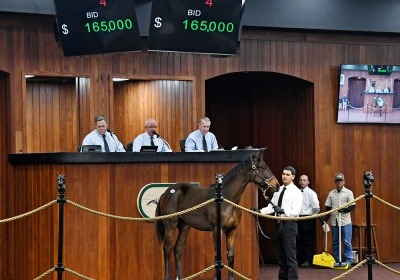
“OBS Holds Its Own as Sales Hum to Life” – Daily Racing Form
“It’s just a continuing move of the industry in trying to get back to normal” – OBS Sales Director Ted Wojchiechowski
Looking at the industry media’s coverage of the just-concluded Ocala Breeders Sales Co.’s spring sale of two-year-olds in training – a sale delayed from its usual April dates to mid-June because of the COVID-19 pandemic – one might conclude that things aren’t so bad after all. The equivalent OBS sale in 2019 set records, so no one would have expected this year’s offering to improve on that. And, at a cursory glance, this year’s auction wasn’t that bad.
And it’s true: if one just looks at the gross figures for the sale, well, it doesn’t seem so bad. The most up-to-date figures show that 641 horses were sold (out of a total of 1315 in the catalogue, or 48.7%, compared to 674 out of 1221 (55.2%) last year). Gross sales volume this year was reported as $59.3 million, compared to $72.9 million in April 2019, a drop of nearly 19 % – significant but not catastrophic. Average price this year was $92,527, a decline of 14.5% from last year, and the median dropped from $60,000 in 2019 to $50,000 this year. And both sales reported three million-dollar juveniles. (These numbers include quite a few “post-sale” private purchases of horses that failed to meet their reserve but were then bought on the sales grounds before their consignors had to ship them back home; final numbers may change slightly from those reported so far.)
If one looked just at those summary figures, it might seem that a bloodbath had been averted, and that the sale was just a market correction after last year’s irrational exuberance. But in fact, this year’s sale was a bloodbath. That’s because the just-concluded auction was in fact two separate sales rolled into one. First, there was the usual OBS spring sale, with 1,231 horses in the original catalogue. Then, tacked onto that, there was a sale of another 84 supplemental nominees, virtually all of them horses that had been listed for sale at the prestigious Fasig-Tipton Gulfstream sale that was scheduled for the end of March but cancelled because of the pandemic. If we look at those two sales separately, then the scope of the carnage becomes apparent.
First, the regular OBS spring sale. Of those 1,231 horses listed, 612 were sold, or just under 50%. Another 124 failed to meet their reserve in the ring and were not sold before they left the sales grounds. The rest were scratched, either before the breeze show or after turning in sub-par breezes. In contrast, last year 674 of the 1,221 horses listed, or 55.2%,were actually sold, and for more money. Gross proceeds for the 612 sold this year were $48 million, compared to $72.9 million last year, a decline of more than one-third. Average price this year was $78,423, a drop of 27.5% from 2019, and the median dropped to $45,000 from last year’s $60,000. All in all, one could say that this year’s spring sale was off by about a quarter from last year, And, perhaps most important, sellers, mostly pinhookers who buy weanlings and yearlings and then try to resell the horses as two-year-olds, left the grounds with $25 million less than they did last year. That’s $25 million less that they’ll be able to bring to the yearling sales that start up again next month.
Treating the supplemental auction of Gulfstream sale refugees as a separate sale, 29 of the 84 horses listed in the catalogue were sold, another 13 failed to meet their reserve, and exactly half, or 42 horses were scratched. Many of those were in fact bought privately by bloodstock agents roaming the Ocala area in the weeks before the sale, though typically at prices that let the consignors just break even on their costs and expenses. The 29 horses that sold at OBS brought a total of $11,315,000, for an average of $390,172 and a median price of $280,000. And they included two of the three million-dollar babies in the overall sale, leaving the regular catalogue with just one, compared to last year’s three seven-figure sales.
It’s probably unfair to compare this year’s OBS supplemental sale to last year’s Fasig-Tipton Gulfstream auction, since many of the Gulfstream horses were in fact sold elsewhere. But last year’s Gulfstream sale did average $493,475, with a median of $375,000, So this year’s Gulfstream-at-OBS results are down about the same percentage from last year as this year’s regular OBS spring sale is from its edition of a year ago. Not counting those horses that may have been sold privately, there’s another $18 million that pinhookers had last year but don’t have this year when they go shopping again.
Two big juvenile sales remain: Fasig-Tipton’s Midlantic auction at Timonium MD at the end of June, and OBS’s June sale, now rescheduled for early July. More of the Gulfstream sale refugees will go through the ring at Timonium, and more two-year-olds will be sold privately or end up being raced by their current owners, but the OBS spring results suggest that there will be a lot less money available when large numbers of yearlings go on sale in the fall. And that means the decade-long decline in the size of the North American foal crop may not yet have bottomed out. If so, fewer foals will continue to mean fewer race days and fewer race tracks. With all the major tracks now returning to racing, albeit mostly without spectators, and with cash-short state governments likely to take a new look at casino subsidies for tracks when those casinos re-open, the outlook for the remaining minor-league tracks is anything but healthy.



